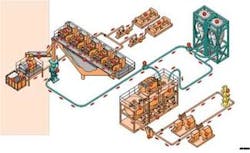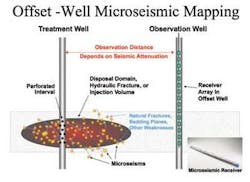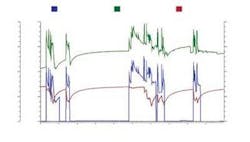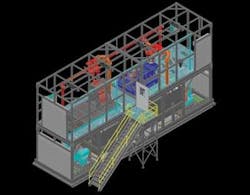Subsurface waste injection taking quantum technical leap
Jim Redden - Contributing Editor
Today, cuttings injection has advanced from a simple pumping operation to a scientifically engineered technology that, when designed and monitored correctly, represents a permanent and liability-proof waste disposal option. What was once a straightforward pumping operation now employs sophisticated wellbore modeling software, dedicated geoscientific teams, and new generation configurations that essentially decouple drilling and injection operations, allowing both to continue simultaneously with no operational interruptions, while still delivering required fluid volumes and pressures.
Dr. Quanxin Guo likens the evolution of subsurface drilling waste disposal to visiting a country physician for a rudimentary check-up as opposed to going to a big-city specialist for a more thorough examination.
“When I look at where we’ve come in cuttings injection, I compare it to going to a doctor to just have your temperature and pressure taken to having an MRI to see what is really going on inside,” says the M-I SWACO global technical advisor and fellow for geomechanics.
All this is a far cry from bygone ventures where cuttings injection was known colloquially as “pump, dump and hope.” At that time, operators would simply drill an injection well, pump in treated and slurrified drill cuttings and hope they stayed there. Unfortunately, often times they did not and would breach to the seabed resulting in a quagmire of economical, environmental, legal, and PR headaches.
“Subsurface injection is not the easiest disposal option, nor is it the least expensive for every project,” says Guo. “However, if engineered and operated properly, the re-injection (CRI) of drill cuttings and other associated waste streams in deep geology is often the most cost effective and environmentally acceptable method of permanently disposing of these waste products.”
CRI interest growing globally
M-I SWACO presently has 20 CRI projects ongoing worldwide, both offshore and onshore, including high-profile projects in the Sakhalin Islands, Caspian Sea, Mexico’s Bay of Campeche, and the North Sea where it has been estimated that 30% of the rigs and platforms use annular subsurface injection for the disposal of oil-base drilling fluid cuttings.
“Mexico is definitely expanding and we are seeing more interest in Southeast Asia and (China’s) Bohai Bay, but we are also seeing growth throughout the world. It used to be CRI was reserved only for wells in environmentally sensitive areas, but now the technology is such that it is being used quite a bit in more routine operations. Today, we are injecting as much as 1 MMbbl in some of these wells.”
He added that current commodity prices have not impacted CRI projects to date, as most have been in the planning stages for about two years.
Ron Morris, global operations manager for Halliburton’s Baroid Surface Solutions, agrees with Guo that developing nations are looking more and more at CRI as a viable disposal option. He says the appeal is not just a function of government regulations, but also the self-imposed environmental policies of international operators.
“I can see large-scale CRI projects coming up in some of the developing countries. Southeast Asia, for example, has a number of (CRI) possibilities and we are seeing more interest in Russia. I definitely see growth in CRI, because operators are looking harder at finding a method at the well site to safely dispose of drill cuttings and other wastes,” he says.
While the Gulf of Mexico still allows discharge of cuttings generated by water-based and synthetic-based drilling fluids provided they fall within a prescribed fluids-on-cuttings ratio, some say the new US administration and its emphasis on tightening environmental standards could alter the landscape dramatically.
Diego Paz, program manager for Baker Hughes Fluid Environmental Services (FES), says if the US ever lifts its moratorium on drilling off the east and west coasts, a prime market for the disposal technology could open. “We do a lot of injection off California, so it certainly would make sense to use it on the east and west coasts.”
Most contend that cuttings injection itself may be a misnomer as this technology easily could be applied to produced water, CO2 sequestration, or any other type of wastes. Regardless of what is pumped into the dedicated wellbore, there must be assurances that it will remain there. The key is to fully understand the behavior of the material once it is pumped into the hole.
Mounds Cuttings Injection test
One of the most prominent investigations into the downhole behavior of injected wastes was the 1998 Mounds Cuttings Injection test in Oklahoma. Architects of the experiment, which was carried out under the auspices of a consortium of operators and service companies, says that while it was a small-scale onshore test, its conclusions definitely are relevant to offshore structures where onboard space is at a premium.
The study employed emerging microseismic mapping technology, which is used widely in hydraulic fracturing for unconventional oil and gas plays, and downhole tiltmeters, which are instruments designed to measure very small changes from the horizontal level, either on the surface or in underground structures.
“The basic idea was to simulate a number of small volume injections to try and see exactly what happens to the material downhole. First, we wanted to determine if you could monitor it using microseismic mapping and both surface and downhole tiltmeters. We measured the bottomhole pressure, used chemical tracers, and drilled core holes to intersect the intervals where the material was injected to allow us to observe what it actually looks like,” says Dr. Norm Warpinski, chief technology officer for Pinnacle Technologies, which Halliburton acquired in October.
“Basically, what is happening with microseismic is that when you are injecting downhole, you are changing the stress and pressure significantly. Those changes in stress and pressure are what causes slippages, which are microseismic, to occur. They only can occur when there’s been some change in the reservoir, otherwise they are pretty stable.”
Warpinski and others involved in the investigation say the Mounds project met all its intended objectives, particularly when it came to studying the feasibility of using microseismic mapping, tiltmeters, and other downhole instrumentation to monitor the injection process.
“Traditionally, you would watch the pressure and occasionally do a temperature log, and that normally is how you dealt with cuttings injection. While you can tell a great deal from pressure and temperature, if you need and want more information there are many things that can be done to provide you a lot more data on what is occurring downhole,” he adds.
In recent years, service companies engaged in the CRI process have taken that pronouncement to heart and augmented their technical arsenal. In 2005, M-I SWACO formerly introduced a multi-disciplinary CRI Assurance Process methodology that comprises a dedicated group of geomechanics, geologists, engineers, and specially designed engineering software for a site-specific, cradle-to-grave approach to subsurface injection. The company CRI portfolio also includes the industry’s only CRI training centers in Aberdeen, Houston, and Bangkok.
Guo says the process begins with initial feasibility studies, continues through constant monitoring of the injection process, and ends with a post-injection analysis.
“The CRI Assurance Process closes the information loop by using real-time-acquired data to perform a post-injection comparison with the pre-injection feasibility analysis,” he explains.
Halliburton’s Baroid Surface Solutions, likewise, is a player in CRI with its FullCircle Cuttings Injection Service that capitalizes on the company’s pressure pumping, fracturing services, and drilling fluid capabilities, and includes designing and manufacturing slurrication, pumping, and other surface equipment.
“Our work is mainly designing and manufacturing equipment and putting together the entire operational process of actually conducting the service of cuttings injection,” Morris says, pointing to the company’s mobile CRI unit that, he says, is adapted easily from onshore to offshore.
He says reservoir modeling is one function many operators choose to execute using their own in-house expertise. “We find some clients want to control the modeling process, and prefer to do it on their own.”
Paz agrees, but adds the landscape is starting to change.
“The biggest asset of most operators is their understanding of the reservoirs, which they transfer into injections. We kind of walked away from modeling a few years ago. We left that to the customers and focused on the surface side of it. Now, we are revamping our modeling (capabilities) as we speak, because we are seeing a lot of large international projects where the customers have no experience with CRI,” he says.
Overcoming deepwater cost
Guo predicts that future technology development could open the way for cuttings injection to become an effective option for the deepwater. He also says work is under way in looking at possibilities for non-annular subsea injections. However, he and others say it all comes down to economics.
“Certainly, deepwater operations lend themselves to more ingenious solutions, but it’s all driven by price,” says Halliburton’s Morris. “However, at an offshore location and particularly in deepwater there definitely could be some financial justification for doing it.”
Then again, Paz says surmounting the financial hurdles promises to be a formidable endeavor. “It is not impossible, but it will be very expensive. In deepwater when you’re drilling without a riser, you would need a dedicated line for the cuttings injection. They tried that in Norway a few years ago and it can run into the millions of dollars to set up the necessary infrastructure just to have an umbilical running from the surface to the wellhead on the seafloor,” he says.
Modeling, monitoring keys
In the meantime, the thrust of emerging injection technology focuses on modeling a perspective disposal well and monitoring the project execution. M-I SWACO, for example, employs a dedicated software suite that, among other functions, analyzes the propagation of hydraulic fractures. The company also uses a proprietary application that allows engineers to “analyze injection performance by visualizing various characteristics at the well such as surface pressure, bottomhole pressure, bottomhole temperature, density, and pump rate for prolonged periods of time using data at one-second frequency,” says Sub-Surface Injection Project Manager Adriana Ovalle.
“I think we have barely scratched the surface of what we can do with monitoring in these types of applications,” says Warpinski. “When you talk about smart wells and all the downhole instrumentation, it would not surprise me for that really to become an integral part of waste injections going forward. I see a time where we can use downhole instruments to monitor the well and really understand what is happening.”
“There will be development on the scientific side on better understanding of the containment mechanism,” says Paz. “A lot of people are looking into it, but not enough compared to those looking a regular fracturing for stimulation purposes. This needs to be better understood and developed, so more operators can feel confident about the technology.
“Monitoring is a big issue, but so are modeling, containment, and understanding the behavior. Obviously there has to be a theoretical and empirical side for both, but that is true of any technology.”
While the potential for new technologies aimed at reducing costs are in the works, Halliburton’s Morris says it already is one of the most value-added disposal options available.
“No, it’s certainly not the cheapest, but if you look at the long-term aspects and the liability issues, I think there is a very strong argument that this is a cost-effective method of drilling waste disposal.”





